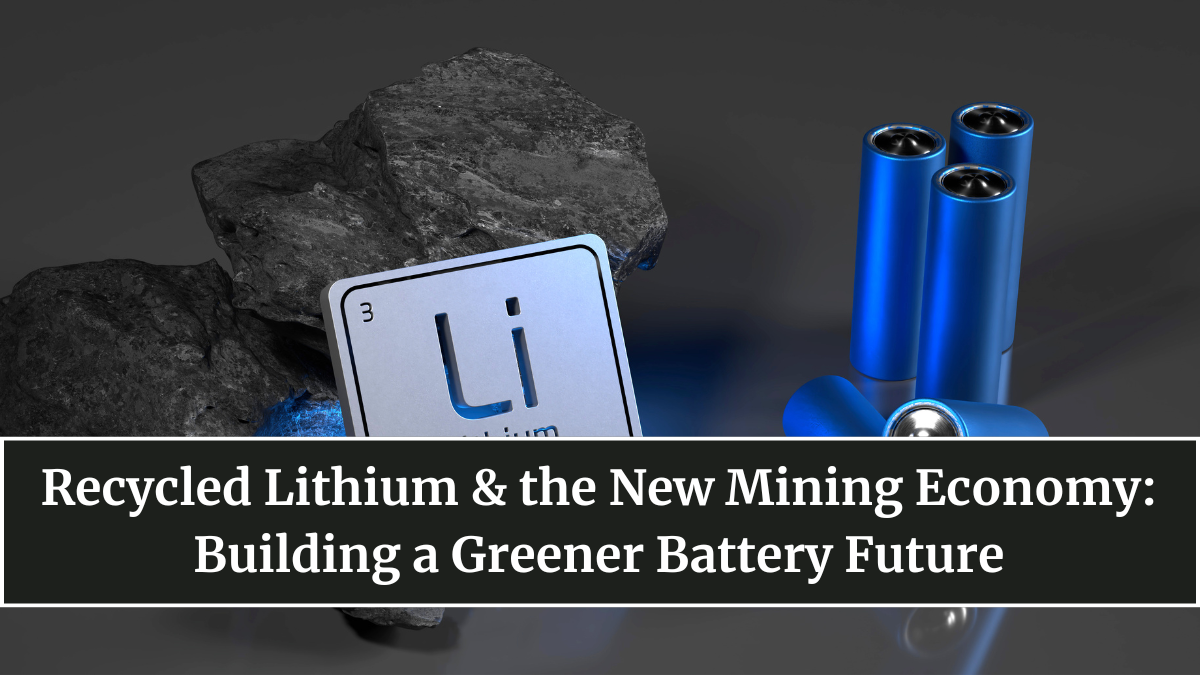As the electric vehicle (EV) revolution accelerates, the world faces an equally pressing challenge — securing enough lithium to meet skyrocketing battery demand. In 2025, recycled lithium has become the cornerstone of a sustainable battery supply chain, helping reduce dependency on mining and supporting the circular economy. By recovering valuable materials from used batteries, industries are creating a closed-loop ecosystem that powers the next generation of green mobility.

Why Lithium Recycling Matters
Lithium is the heart of every EV battery. However, mining new lithium is resource-intensive and environmentally damaging. Extracting it from brine or rock consumes large amounts of water and energy, often leading to ecological disruption. With EV demand expected to triple by 2030, relying solely on traditional mining is neither feasible nor sustainable.
That’s where lithium recycling steps in. By reclaiming lithium, cobalt, and nickel from old or damaged batteries, the industry can cut costs, lower emissions, and reduce the geopolitical risks tied to raw material sourcing. Recycled lithium is now proving that sustainability and profitability can go hand in hand.
How Lithium Recycling Works
Modern recycling facilities use advanced hydrometallurgical and direct recycling methods to extract lithium from spent cells. The process typically involves:
-
Battery Collection and Disassembly – Used EV or consumer batteries are sorted and safely dismantled.
-
Material Separation – Electrolytes and metals are separated using thermal and chemical treatments.
-
Refinement and Purification – Extracted lithium compounds are purified and reused for new cathodes.
Unlike traditional smelting, these new techniques preserve up to 95% of battery materials, drastically improving sustainability metrics.
Leading innovators like Li-Cycle (Canada), Redwood Materials (US), and Attero Recycling (India) are investing heavily in recycling infrastructure, setting up large-scale plants capable of processing thousands of tons annually.
Economic Benefits and Global Expansion
The recycled lithium market is booming as governments and automakers realize the cost and environmental benefits. Manufacturing batteries with recycled lithium can reduce production costs by up to 20%, while ensuring supply stability.
Countries like India, the US, and Australia are introducing policies to encourage local recycling industries. India’s 2025 Battery Waste Management Rules, for instance, make it mandatory for manufacturers to recover and reuse materials from discarded batteries.
Moreover, automakers such as Tesla, BYD, and Tata Motors have started direct partnerships with recycling firms to close the loop on their battery ecosystems, ensuring that end-of-life batteries become the foundation of new ones.
Environmental Impact and Sustainability Goals
Every ton of recycled lithium prevents up to 15 tons of CO₂ emissions compared to mining. It also saves over 70% of the water typically used in extraction. The shift toward recycling directly supports global net-zero targets and reduces reliance on unstable mining regions.
In addition, recycling mitigates the growing challenge of battery waste management, which can otherwise lead to toxic leakage and landfill pollution. By reintegrating old materials into new batteries, companies are contributing to a true circular economy — where resources never go to waste.
Innovations in Lithium Recovery
The next generation of recycling technology focuses on AI and automation. Smart sorting systems identify battery chemistries for faster processing, while robotic disassembly lines improve safety and precision.
Emerging technologies like direct cathode-to-cathode recycling and electrochemical extraction further minimize energy use. Some startups are even experimenting with urban mining, where used electronics and e-scooter batteries are repurposed for EV-grade lithium recovery.
These innovations are not only improving efficiency but also positioning recycled lithium as a viable, scalable alternative to traditional mining.
The Future of Recycled Lithium
By 2025, recycled lithium is no longer just an environmental initiative — it’s a global economic driver. Analysts predict that by 2030, over 40% of new EV batteries will use materials sourced from recycled components. This transition will create thousands of green jobs, reduce supply bottlenecks, and stabilize battery prices.
As the world shifts toward clean mobility, recycled lithium 2025 stands as a symbol of progress — showing that the future of energy doesn’t depend on digging deeper, but on using smarter, cleaner, and more sustainable resources.
FAQs
What is recycled lithium?
Recycled lithium is lithium recovered from used or end-of-life batteries and refined for reuse in new battery production.
Why is lithium recycling important?
It reduces environmental damage, conserves resources, and creates a sustainable circular economy for EV batteries.
How is lithium recycled?
Through hydrometallurgical or direct recovery methods, which extract and purify lithium compounds for reuse in new batteries.
Which companies are leading in lithium recycling?
Li-Cycle, Redwood Materials, Attero Recycling, and Umicore are among the key global players.
What is the future of recycled lithium?
By 2030, recycled lithium will supply a significant portion of the world’s battery demand, cutting costs and helping achieve global climate goals.
